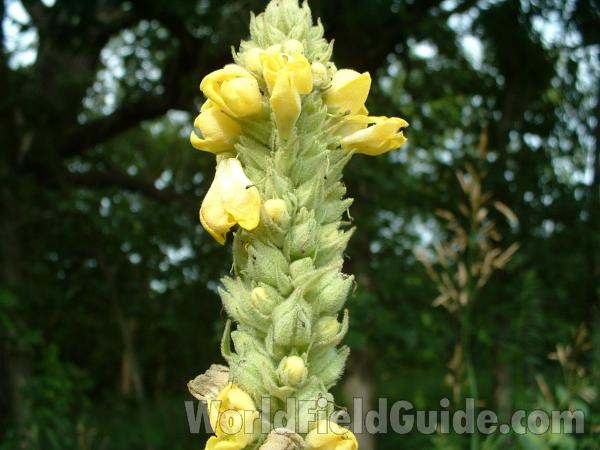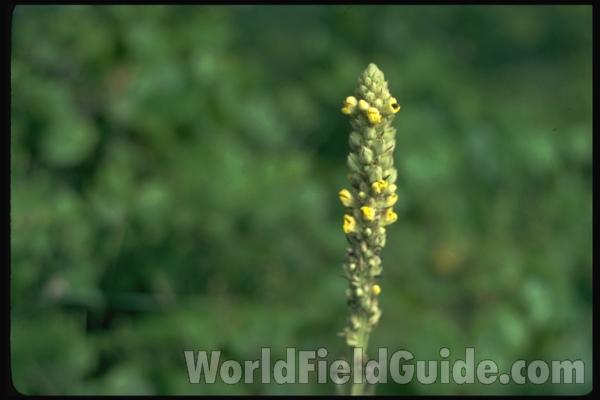SPECIES INFO
Great mullen (Verbascum thapsus) is native to Eurasia, but is now established widely and commonly in North America. This densely woolly weed can grow to seven feet tall. The oblong leaves can be up to one foot long. The yellow flowers are in dense elongated spikes.
This plant has an elongated flower head, but only a few flowers bloom at a single time. The flowers are yellow, and certainly not tiny.Verbascum genus is native to western and central Eurasia and northern Africa. There are about 300 species of herbs and somewhat woody herbs in this genus. Most species have alternate leaves and flowers in terminal spikes. As of l994 there were 11 species established in greater North America.
These are mostly tall erect biennial herbs. The leaves are usually alternate, and the flowers are rather large. The calyx is deeply 5 parted or cleft.
Figwort Family (Scrophulariaceae) contains approximately 3,000-4,000 species of wide distribution arranged in about 220 genera. There are herbs, shrubs, and trees, with most species having irregular flowers. As of 1994, there were about 834 species in 82 genera either native to or established in greater North America, including Puerto Rico, the Virgin Islands, Hawaii, and Greenland.
The boundaries of this family are open to radical changes and numerous discussions.
Tubiflora Order of plants is comprised of a large number of families that are characterized by having tube-like flowers. Several of the families have asymmetrical flowers with various lip and lobe configurations, while others have symmetrical flowers. The convention is to refer to the corolla divisions as lips, and to refer to the extensions at the end of the lips as lobes. This large order can be divided into two groups of families: those families with flowers with radial symmetry and those families with flowers with bi-lateral symmetry.
Some modern authors have divided this order into two different orders: The Lamiales including the mints and snapdragons and the Solanales including the morning glory and tomato families.
Dicots (Dicotyledoneae Class) are the predominant group of vascular plants on earth. With the exception of the grasses (Monocots) and the Conifers (Gymnosperms), most of the larger plants that one encounters are Dicots. Dicots are characterized by having a seed with two outer shell coverings.
Some of the more primitive Dicots are the typical hardwood trees (oaks, birches, hickories, etc). The more advanced Dicots include many of the Composite (Aster) Family flowers like the Dandelion, Aster, Thistles, and Sunflowers. Although many Monocots reach a very high degree of specialization, most botanists feel that the Dicots represent the most advanced group of plants.
Seed plants (Phylum Embryophyta) are generally grouped into one large phylum containing three major classes: the Gymnosperms, the Monocots, and the Dicots. (Some scientists separate the Gymnosperms into a separate phylum and refer to the remaining plants as flowering plants or Angiospermae.)
For North American counts of the number of species in each genus and family, the primary reference has been John T. Kartesz, author of A Synonymized Checklist of the Vascular Flora of the United States, Canada, and Greenland (1994). The geographical scope of his lists include, as part of greater North America, Hawaii, Alaska, Greenland, Puerto Rico, and the Virgin Islands.
Kartesz lists 21,757 species of vascular plants comprising the ferns, gymnosperms and flowering plants as being found in greater North America (including Alaska, Hawaii, Greenland, Puerto Rico and the Virgin Islands.
There are estimates within the scientific world that about half of the listed North American seed plants were originally native with the balance being comprised of Eurasian and tropical plants that have become established.
Plant kingdom contains a large variety of different organisms including mosses, ferns, and seed plants. Most plants manufacture their energy from sunlight and water. Identification of many species is difficult in that most individual plants have characteristics that have variables based on soil moisture, soil chemistry, and sunlight.
Because of the difficulty in learning and identifying different plant groups, specialists have emerged that study only a limited group of plants. These specialists revise the taxonomy and give us detailed descriptions and ranges of the various species. Their results are published in technical journals and written with highly specialized words that apply to a specific group.
On the other hand, there are the nature publishers. These people and companies undertake the challenging task of trying to provide easy to use pictures and descriptions to identify those species.















